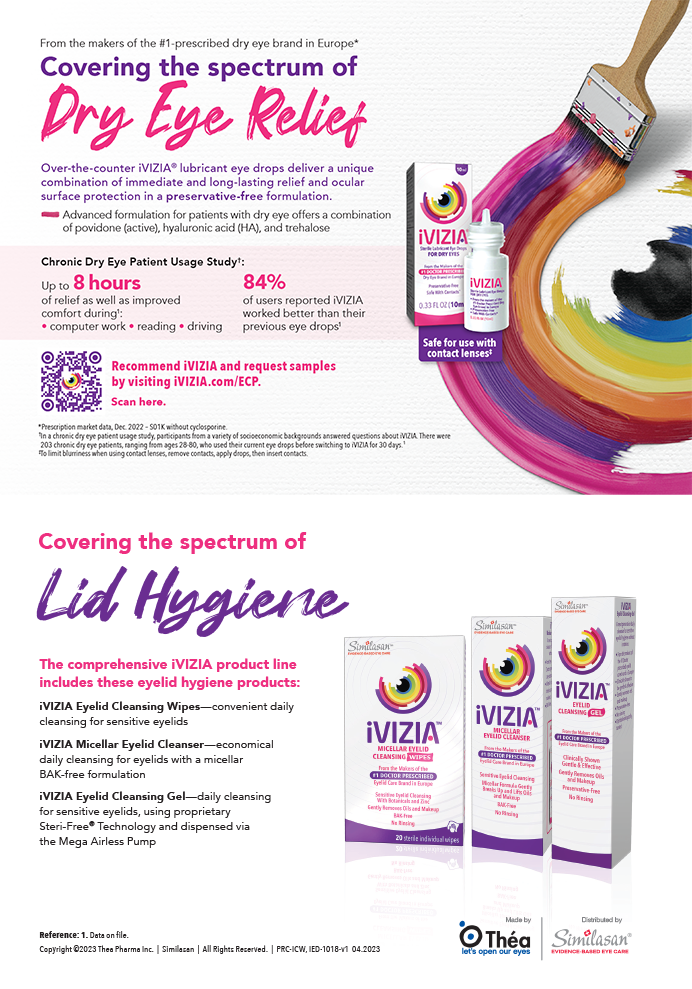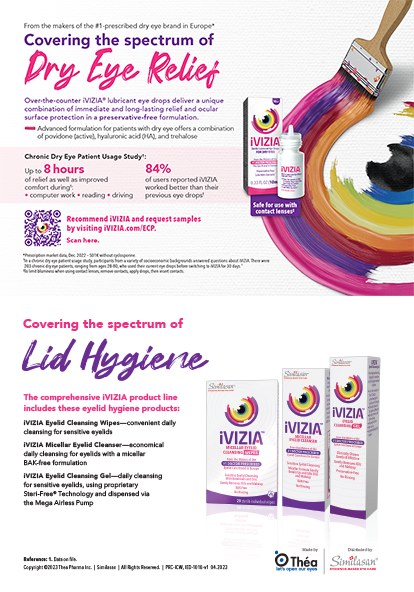Cataract extraction and IOL implantation is one of the most frequently performed surgical procedures today. An extremely important component of this procedure is implanting an IOL of the correct power. Exact preoperative measurements are essential, as IOL power calculation formulas base their results on the accuracy of the data used in the calculations. These data include the axial length, central corneal power, anterior chamber depth (ACD), and the lens constant for the IOL being used.
FINAL REFRACTIVE OUTCOME
The haptic configuration and optic design of an IOL influence the final refractive outcome, as they define the postoperative positions of the lens' principal planes. Jack Holladay, MD, Clinical Professor of Ophthalmology at Baylor College of Medicine in Houston, TX, provides an example of a normal lens that is angulated 10º and has a 6-mm diameter when placed in the bag. This lens usually ends up about 5.25 mm behind the corneal vertex. However, Dr. Holladay clarifies that the position of the lens depends on the flexibility, configuration, angulation, and diameter of the haptics, as well as the design of the optic. ?Once the lens is in the eye,? he says, ?the lens constant is actually based on the position of the lens in an eye that is 23.5 mm long, has a cornea about 44 D, and has a normal corneal ‘white-to-white' diameter of 11.7 mm.? The lens formulas calculate where the lens would be for a specific patient due to patient variables, not lens variables. According to Dr. Holladay, the most important factor of the refractive outcome is the surgeon, ie, the consistency of the surgeon inserting the lens in the same place in the bag each time.
Wolfgang Haigis, PhD, a physicist from Universitäts-Augenklinik in Würzburg, Germany, explains that the object and image principal planes lie closely together and are usually replaced by one “effective” plane. The distance from the anterior corneal surface is called the optical ACD or the effective lens position (ELP), as coined by Dr. Holladay. “Because the ELP combined with the axial length and corneal power determines the IOL power, it is one of the most important and challenging tasks in IOL calculation to predict the ELP for a given eye,” states Dr. Haigis.
THE EFFECT OFCAPSULOTOMY ON IOL POWER
Dr. Holladay says that capsulotomy and anterior chamber capsule contraction usually cause an increase in the IOL power. Any forward movement of a positive lens in the eye will cause a person's refraction to shift in a myopic direction. Any posterior movement of a positive lens causes a person to shift in the hyperopic direction. Entrapment of viscoelastic material may also result in an unexpected myopic shift. “Another situation that I have seen,” Dr. Holladay mentions, “is that as the bag contracts, it sometimes moves forward and even if there is nothing behind it, this results in a shift toward myopia over time.” Dr. Haigis adds that various IOL designs will react differently in the setting of capsular contraction. “In plate or multipode haptics, the refractive result (unwanted myopia) cannot be explained by a dislocation alone,” he says. There are indications that the lens curvature may be affected by the contractive forces of the capsule, causing a change in effective IOL power, adding to the dislocation effect.
Holladay 1
In 1988 when Dr. Holladay created the Holladay 1 formula, he used the axial length and keratometry to determine the ELP using the Fyodorov formula to calculate corneal height. Likewise, the SRK/T formula used a similar method to predict the ELP while the Hoffer Q formula also used axial length and K but in a different manner (tangent of K) to predict the ACD. These three formulas became grouped together when Dr. Hoffer used all three in the first Windows computer IOL power calculation program for clinical use (Hoffer Programs) and are referred to as third-generation formulas. The Holladay IOL Consultant used a similar system and added the Holladay 2 formula.
Holladay 2
The Holladay 2 formula uses seven variables to predict lens position, and is derived from the result of a study that Dr. Holladay conducted in which he used data on myopic and hyperopic eyes from 35 surgeons (30,000 cases) around the world. In addition to the axial length and keratometry, Dr. Holladay and his colleagues asked these surgeons to measure the horizontal ?white-to-white? corneal diameter, the ACD, the lens thickness, the refraction, and the age of the patient.
Hoffer Q
Kenneth J. Hoffer, MD, Clinical Professor at UCLA, from St. Mary's Eye Center in Santa Monica, CA, states that his studies showed that the Hoffer Q is more accurate in eyes less than 22 mm (short), and the SRK/T formula is more accurate in eyes that are greater than 26 mm (very long). For eyes between 24.5 to 26 mm (medium-long), the Holladay 1 formula works the best. He states that the three formulas work relatively equally well for eyes between 22 and 24.5 mm (average). This was the result of a study on 450 eyes in 1993 and 860 short (<22 mm) eyes in 1996. The Hoffer Q is excellent to use in short and average eyes, the Holladay formula is good to use in average to medium-long eyes, and using the SRK/T is preferable in very long eyes, he notes.
With the advent of the Holladay 2 formula, Dr. Hoffer repeated the study on 317 eyes by one surgeon using one IOL design and compared it to the three previous formulas. He used the Holladay IOL Consultant to analyze the data. The results showed that the Holladay 2 improved its accuracy in the extremes—the short and very long eyes—but unfortunately showed worse accuracy in the average and medium-long eyes (85%) than the three other formulas.
Haigis FormulaWhereas other formulas use only one constant (such as the ACD, the A-constant, or the surgeon factor) for a given IOL, Dr. Haigis' algorithm uses three (a0, a1, a2). The a1 constant is tied to the measured ACD.
The a2 constant is tied to the measured axial length. “The way that the a0, a1, and a2 constants are set,” explains Warren Hill, MD, from East Valley Ophthalmology in Mesa, AZ, “is to generate a set of IOL-specific outcomes for a range of axial lengths and ACDs. By regression analysis, the a0, a1, and a2 constants are adjusted to match the actual observed results for an individual surgeon and specific IOL.” In addition, apart from the axial length, the ACD is also taken to serve as a predictor for the postoperative IOL position. Dr. Haigis offers, “The three constants can be derived from a statistical analysis of postoperative refractive results for a sufficient number (n > 50) of patients supplied with the lens in question.” According to Dr. Haigis, by individualization of three constants, allowance can be made for individual IOL geometry as well as axial length range. This is not possible with the one-constant approach of the other IOL calculation formulas.
THE IOLMaster
Dr. Holladay believes that the IOLMaster (Zeiss Humphrey Systems, Dublin, CA) performs better in measuring the axial length in eyes that do not have dense cataracts, either posterior subcapsular cataracts, and/or dense nuclear (sclerotic) cataracts. Dr. Hoffer mentions that although the IOLMaster is a major development, there are cases in which the IOLMaster will not work. In dealing with posterior subcapsular cataracts, it can be nearly impossible to perform the axial length measurement with the IOLMaster. “Approximately 8% to 10% of eyes cannot be measured with the IOLMaster,” states Dr. Hoffer. Therefore ultrasound will still be needed and, he says, it has been proven by many studies that immersion ultrasound is more accurate than contact A-scan.
The IOLMaster also measures the ACD using an optical method as well as the K readings. ?The K readings (from the IOLMaster) are probably not quite as accurate as those from the manual keratotomer, ? he continues. ?Overall,? he concludes, ?the instrument is excellent, and can be used to measure eyes containing silicone oil, which is practically impossible to measure using ultrasound.?
PERFORMING IOL MEASUREMENTS
Many surgeons feel that technicians are perfectly capable of performing IOL power calculations. Dr. Hoffer states that there are technicians who can do axial length measurements and IOL calculations better than many surgeons. Dr. Holladay agrees with Dr. Hoffer, and adds, ?It's always the ophthalmologist's responsibility, but certainly we may delegate many tasks to certified ophthalmic technicians, and they may become better at it than we are.? Dr. Haigis notes that an experienced technician who has performed thousands of A-scans is qualified to perform all the necessary measurements.
PERSONALIZING THE A-CONSTANT
In the early 1980s, John Retlaff, MD, recommended personalization in order to improve the poor results seen using the SRK I and later SRK II regression formulas. ?Variations in keratometers, ultrasound machine settings, and surgical technique can all affect outcomes, as they add variables,? says Dr. Hill. ?Personalizing the lens constant is a way to make adjustments for a variety of practice-specific variables in order to achieve the most predictable outcomes, no matter which formula the surgeon is using,? he continues. There are three IOL constants that are typically used to move the predicted power curve of the surgeon's preferred IOL power calculation program up or down.
Dr. Hill explains that the larger the IOL constant, the more IOL power the formula will recommend for the same set of measurements. The smaller the number, the less IOL power the same formula will recommend. ?Studies have proven that personalizing the lens constant will improve your postoperative results in the future,? adds Dr. Hoffer.
Dr. Holladay offers that using the constants provided by the manufacturer will never provide results comparable to personalizing your own. “Your keratotomer, surgical techniques, steroids and drops are unique to each patient,” he says. “In order to achieve optimal results,” he continues, “you need a program to input the postoperative results, so that over time, you have a personalized constant for your patients.”
Jack T. Holladay, MD, MSEE, FACS, is Clinical Professor of Ophthalmology at Baylor College of Medicine, Houston, Texas. Dr. Holladay does not hold a financial interest in the IOLMaster or any of the ultrasounds, and does have a financial interest in the Holladay IOL Consulting Program. He may be reached at (713) 668-7337; docholladay@docholladay.comWolfgang Haigis, MS, PhD, is a physicist at Universitäts-Augenklinik, Würzburg, Germany. Dr. Haigis does not hold a financial interest in any of the materials mentioned herein. He may be reached at +49 931 201-5640; w.haigis@augenklinik.uni-wuerzburg.de
Kenneth J. Hoffer, MD, is Clinical Professor of Ophthalmology at UCLA, Jules Stein Eye Institute and in private practice at St. Mary's Eye Center, Santa Monica, California. Dr. Hoffer does not hold a financial interest in any of the materials mentioned herein other than the Hoffer Programs and Holladay IOL Consultant power calculation software. He may be reached at (310) 451-2020; KhofferMD@aol.com
Warren Hill, MD, is in private practice at East Valley Ophthalmology, Mesa, Arizona. Dr. Hill does not hold a financial interest in any of the materials mentioned herein. He may be reached at (480) 981-6130; info@a-scan.net
Steven H. Dewey, MD, practices in Colorado Springs and is an Associate Clinical Professor at the University of Colorado. Dr. Dewey does not hold a financial interest in any of the materials mentioned herein. He may be reached at (719) 475-7700; deweys@prodigy.net


